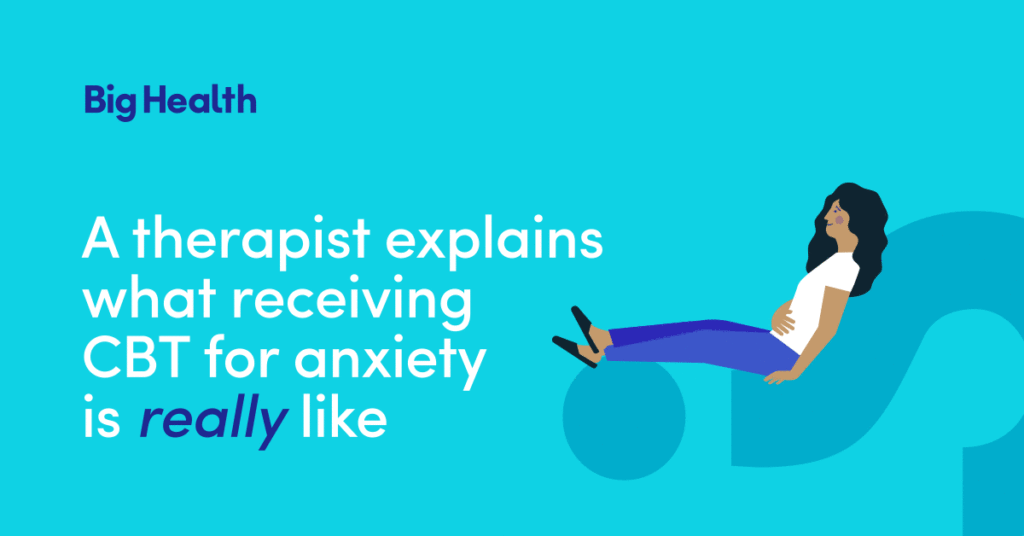Walking into a therapist’s office for the first time can be intimidating, especially if you don’t know what to expect. Mainstream media makes us believe that therapy is simply laying on a couch and revealing our deepest, darkest secrets. We hope to ease some of that tension — and correct those misconceptions — by providing insight into what it’s really like to receive care for anxiety. Our guide for this journey is a cognitive behavioral therapist, Dr. Hannah Boettcher.
Anxiety is one of the most common mental health conditions in the US, with nearly 1 in 3 people meeting diagnostic criteria for an anxiety disorder at some point in their life. Decades of research recommends cognitive behavioral therapy (CBT) as a first-line treatment. CBT is a type of structured therapy that gives people the skills necessary to identify and change unhelpful thoughts and behaviors that are responsible for maintaining a state of anxiety.
CBT for anxiety is more than just talking; it is like working with a personal trainer. The goal of this therapeutic approach is for the client to learn and practice skills directly related to their individual needs. For example, someone suffering from social anxiety (e.g., fear in social settings) might work on taking small steps towards getting comfortable with small talk, while someone with generalized anxiety (i.e., uncontrollable worry) might work on reducing the amount of time they spend worrying.
What “skills” do you learn during CBT?
- Self monitoring: Becoming an expert at tracking our own feelings, thoughts and behaviors — this is how we figure out what and how we’d like to change.
- Challenging anxious thoughts: Instead of treating every thought like it’s worth listening to, we investigate whether a thought is accurate and helpful. If not, we try to come up with other perspectives.
- Mindfulness: Learning how to observe our own thoughts without judgement. This is the exact opposite of what our brains tend to do when we’re anxious.
- Exposure therapy: Facing our fears. Purposefully entering into the situations that make us anxious (as long as they’re safe) and coping with them directly rather than avoiding them. Over time, this technique helps us experience less anxiety in these situations.
Debunking myths about CBT for anxiety
Stigma around mental health remains prevalent in part due to misunderstandings of what treatment looks like. Let’s work to reduce stigma by debunking three typical misconceptions about CBT for anxiety.
Myth: CBT is only for people with clinically diagnosable anxiety disorders.
Fact: Everyone can benefit from CBT for anxiety.
Even if the anxiety you experience feels justified — CBT can be helpful (p.s. check out our blog on differentiating helpful from unhelpful anxiety). We all fall into patterns of negative thinking and develop unhelpful habits. CBT is a powerful mechanism to help break them and form new, healthier habits.
Myth: Progress towards reducing anxiety only happens during therapy sessions.
Fact: Progress towards improved anxiety happens primarily between sessions.
Typically, therapy sessions happen once a week for 45-60 minutes. That means a client will spend less than 1% of their waking hours in therapy. The remaining 99% can be used to practice CBT skills in the context that matters — real life. Like any other habit, people tend to get more out of therapy the more they practice.
Additionally, clinicians often give specific homework for the client to work on between sessions. For example, they might track something, such as what triggers their anxiety. Or they’ll practice a skill like relaxation to reduce tension or talking to themselves as they would a friend when they notice self-critical thoughts. Clients may also engage in activities they previously avoided due to anxiety, like starting a short conversation with someone they don’t know at a party.
Myth: People must stay in therapy as long as anxiety lasts.
Fact: CBT isn’t meant to continue indefinitely, and doesn’t “cure” all symptoms. Instead, therapy ends when the client feels comfortable independently applying skills to cope with anxiety.
As a clinician, I want my clients to put me out of business. The goal is to help them become so capable and confident about using CBT skills that they can be their own therapist. With a toolbox of CBT skills, the client feels better equipped to meet life’s challenges — being happier and less anxious is a bonus!
How do you know if you are making progress in therapy?
It’s important to remember that everybody’s experience of anxiety is different. Two people with the same diagnosis will likely have two very different experiences. However, there are typical signs that therapy is helping:
- Stressful situations are easier to handle.
- You’re willing to try things you weren’t willing to do before.
- You’re better at coming up with new ways of thinking about situations.
- Anxiety no longer gets to decide how you behave. You feel empowered to choose how to respond.
Barriers to accessing CBT
We know that CBT is effective at helping people better cope with anxiety. Unfortunately, even in the age of telehealth there are numerous hurdles that prevent people from engaging in therapy:
- Access: Not everyone can find therapy that’s in a convenient location or at a time that fits into their schedule. Plus, therapy waitlists are often months long.
- Cost: Therapy is expensive. Whether someone pays out of pocket or has a copay — if it’s covered by health insurance — a single session can be unaffordable.
- Stigma: Even as attitudes toward therapy are improving (lots of my young adult clients think therapy is trendy!), mental health remains stigmatized when compared to physical health. Stigma is often strong enough to make a client hesitate to get help.
- Time and effort: It’s not easy to block off time every week for a therapy session, and therapy is hard work. When clients are having trouble staying committed to skills practice, we review what motivated them to work on their mental health in the first place, and try to get creative with ways to make practice more convenient.
How can we tear down these barriers?
The use of digital solutions — especially those that are fully automated — provide a new frontier to help remove these barriers to care. In doing so, more people can benefit from evidence-based care such as CBT. From experience, people love having the option to use technology to track progress and stay up to date on skills development. And a self-directed solution is the perfect way for people to practice “being their own therapist” — the ultimate goal of CBT.
The benefit of a digital solution rooted in CBT is that it can be used anywhere, at any time. This is not just a matter of convenience — it also lets the client practice skills right in the moment of need, which is the best time to practice! For folks who aren’t already in therapy, digital solutions offer a more affordable and less stigmatized first step into care. Whether used as a standalone strategy, in combination with therapy or medications, or to sustain skills practice afterwards, digital therapeutics are an essential ingredient of any mental health diet.
Check out Daylight, a fully-automated digital solution to help employees overcome their worry and anxiety. Designed by leading clinical experts, Daylight features cognitive behavioral techniques and is backed by gold-standard clinical evidence. A published clinical study showed 71% of Daylight participants reduced their worry and anxiety, 57% reported improvement in their mood, and 47% experienced improved sleep (Carl et al., 2020).
Disclaimer: In accordance with FDA’s current Enforcement Policy for Digital Health Devices for Treating Psychiatric Disorders During the Coronavirus Disease 2019 (COVID-19) Public Health Emergency, for patients aged 18 years and older, who are followed by and diagnosed with insomnia disorder or generalized anxiety disorder by a medical provider, Sleepio and Daylight can be made available as an adjunct to their usual medical care for insomnia disorder or generalized anxiety disorder, respectively. Sleepio and Daylight do not replace the care of a medical provider or the patient’s medication. Sleepio and Daylight have not been cleared by the U.S. Food and Drug Administration (FDA) for these indications.
Disclaimer: In the UK, Sleepio and Daylight are CE marked medical devices available for the treatment of insomnia disorder and generalized anxiety disorder, respectively


